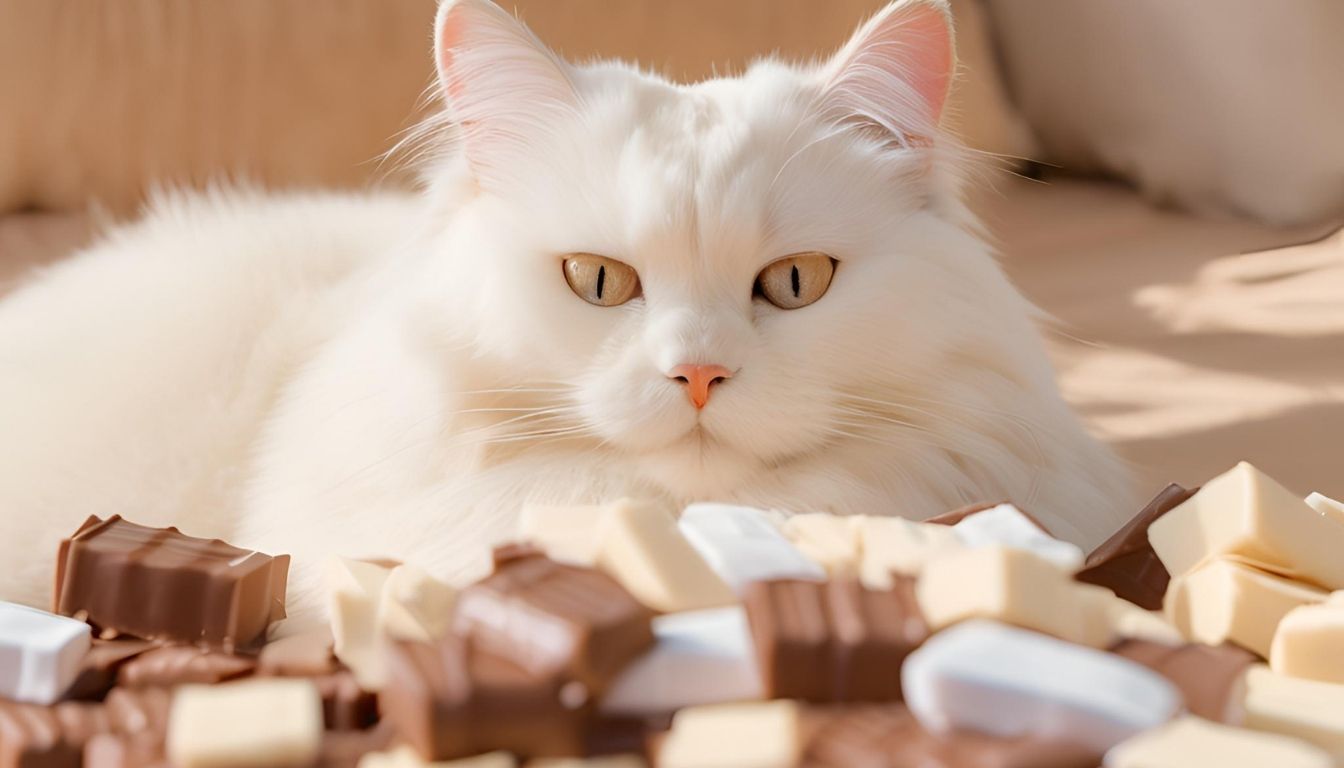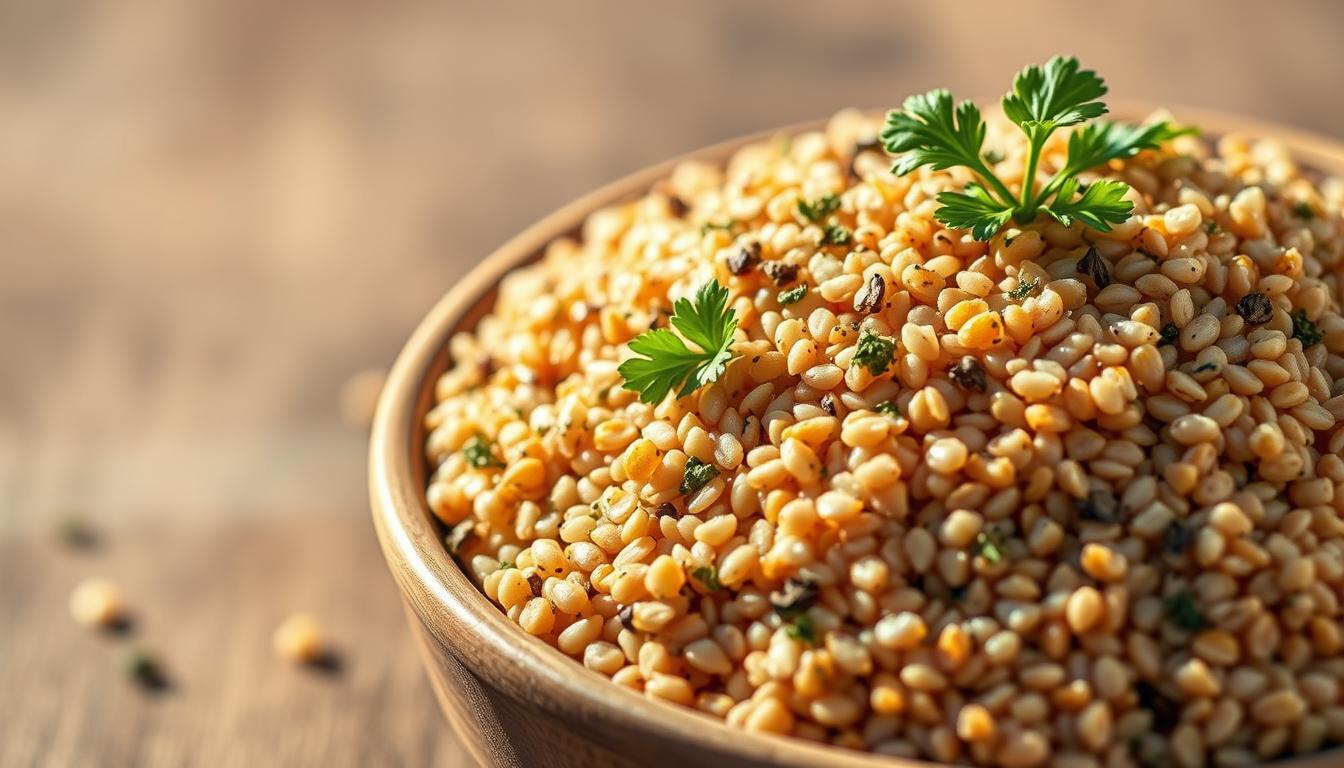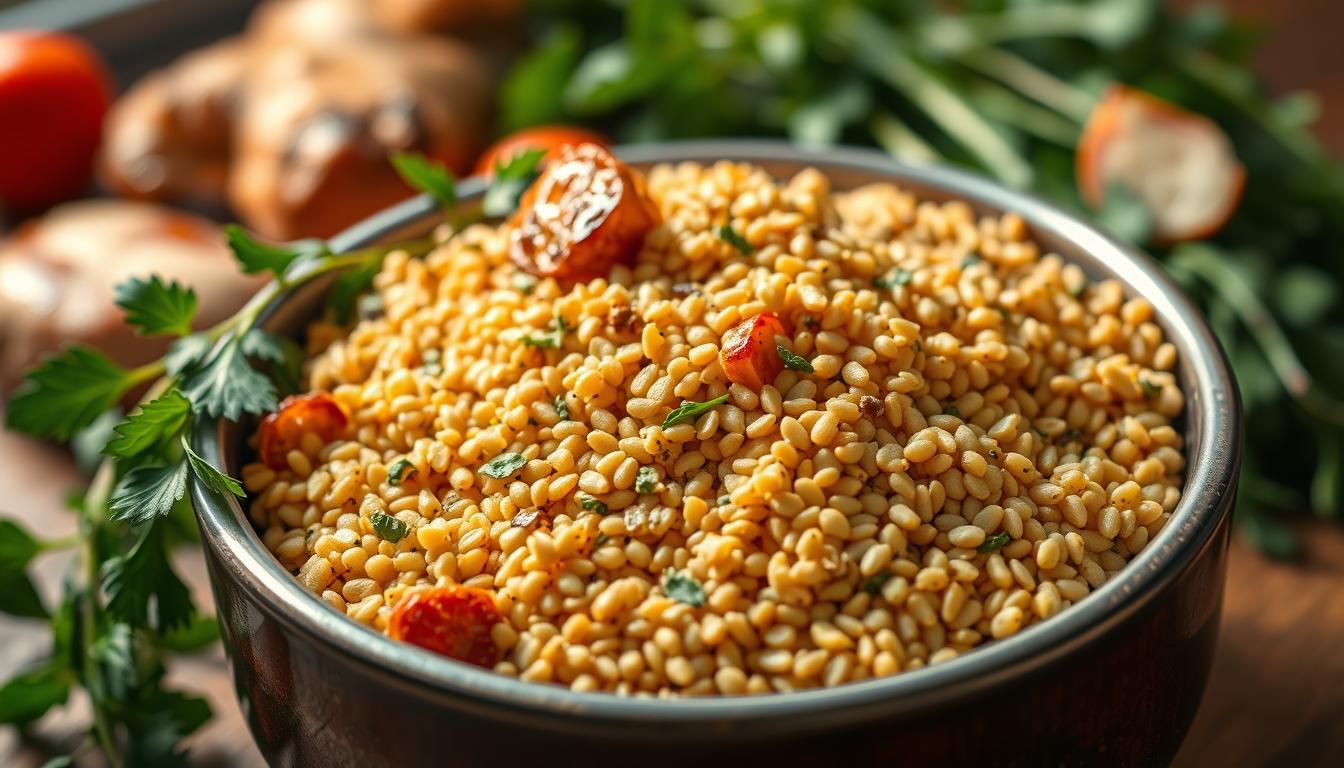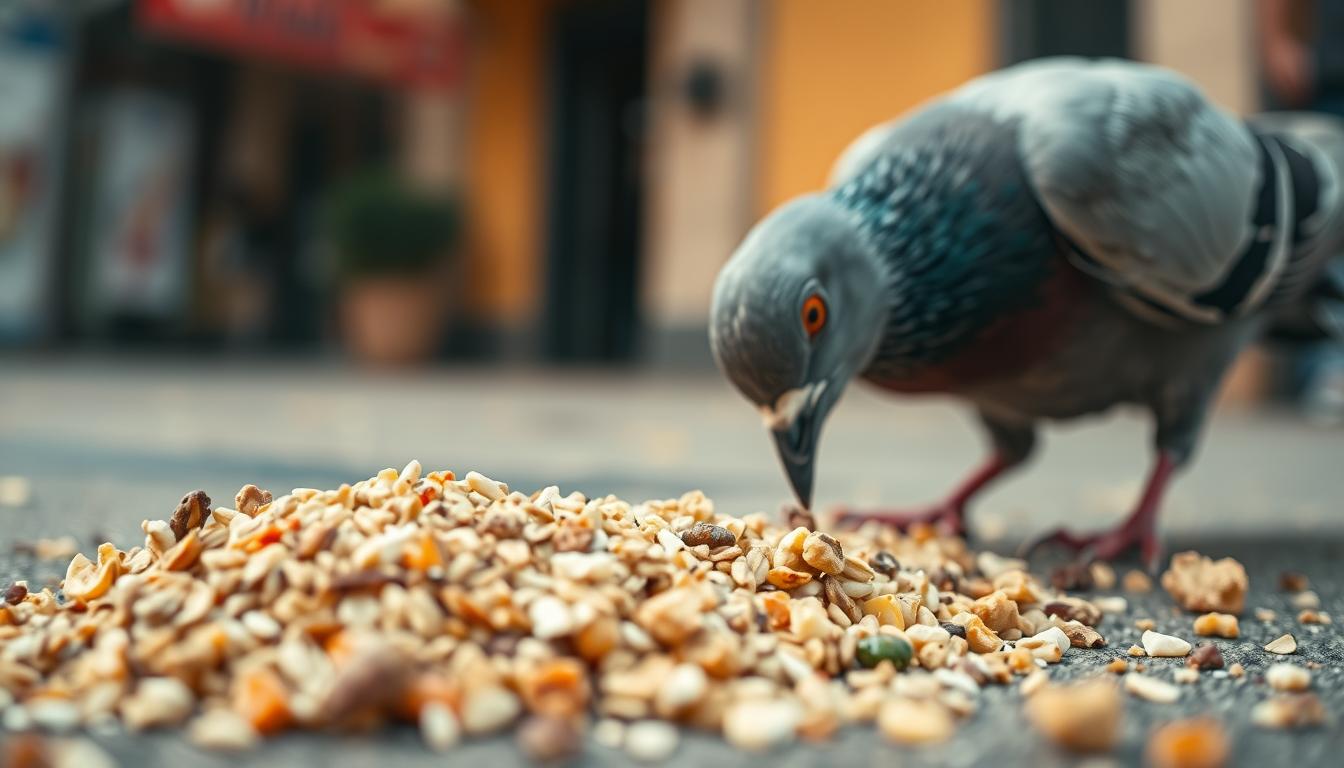As a devoted cat parent, I learned the hard way that some treats can be deadly for our feline friends. One Halloween night, my curious tabby eyed a chocolate bar, unaware of the danger. This sweet temptation was a big risk.
Chocolate is a top toxic food for cats. The short answer is no, cats should not eat chocolate. Theobromine and caffeine in chocolate are toxic and can be life-threatening for your pet.
Pet safety is more than just keeping your cat indoors or up to date on vaccinations. It’s about knowing the dangers that could be on your kitchen counter. Even a small lick of chocolate can harm your cat.
This guide will help you understand chocolate toxicity. You’ll learn why chocolate is dangerous and how to spot poisoning signs. You’ll know how to protect your pet from this deadly threat.
The next few minutes could save your cat’s life. Let’s explore the essential warnings for cat owners about chocolate and its risks.
Table of Contents
Understanding the Dangers of Chocolate for Cats
Chocolate is a big threat to cats that many owners don’t know about. Cats can’t handle chocolate well because of their unique body chemistry.
Chocolate has two bad substances: theobromine and caffeine. These can be very harmful to cats, even life-threatening.
What Makes Chocolate Toxic to Cats
Cats can’t break down theobromine like humans do. Theobromine becomes a silent killer for cats because their bodies process it slowly. This means the toxins build up in their blood, posing serious health risks.
Types of Toxic Compounds in Chocolate
- Theobromine: Primary toxic compound
- Caffeine: Secondary stimulant
- Concentration varies by chocolate type
How Cats Process Theobromine Differently
Cats don’t have the right enzymes to break down theobromine. This makes even a little chocolate very dangerous. The danger level changes with the type of chocolate:
| Chocolate Type | Theobromine (mg/100g) | Toxicity Risk |
|---|---|---|
| Dark Chocolate | 493 | Extremely High |
| Milk Chocolate | 205 | Moderate |
“Even a small piece of chocolate can be dangerous for your cat’s health.” – Veterinary Nutrition Experts
Knowing about these dangers is key to keeping your cat safe and avoiding chocolate poisoning.
Can a Cat Eat Chocolate: The Definitive Answer
The answer is clear: cats should never eat chocolate. Chocolate is very harmful to cats and can even be deadly. It contains toxic compounds that can hurt your cat. So, it’s very important to keep all chocolate away from them.
“Chocolate is a dangerous poison for cats, not a treat.” – Veterinary Nutrition Experts
Here’s why chocolate is so bad for cats:
- Cats can’t break down theobromine and caffeine like people do
- Even a little bit can cause serious health problems
- Dark chocolate is the most harmful for cats
- Symptoms can show up in 2-24 hours after they eat it
The dangers of chocolate for cats depend on a few things:
| Chocolate Type | Toxicity Level | Primary Risks |
|---|---|---|
| Dark Chocolate | Extremely High | Potential cardiac arrest, nervous system damage |
| Milk Chocolate | Moderate | Vomiting, diarrhea, dehydration |
| White Chocolate | Low Toxicity | Potential pancreatitis from high fat content |
When it comes to cats and chocolate, the best thing is to prevent it. No chocolate is safe for cats. If your cat eats chocolate, get them to the vet right away.
Different Types of Chocolate and Their Toxicity Levels
It’s important to know how different chocolates affect cats. Some chocolates are more dangerous than others. Knowing which ones to avoid is key.
Dark Chocolate and Cocoa Powder: Extreme Danger
Dark chocolate and cocoa powder are the biggest threats to cats. They have a lot of theobromine, which is very harmful.
- Baking chocolate: 364 mg of theobromine per ounce
- Dark chocolate: 200-250 mg of theobromine per ounce
- Minimum toxic amount for an 8 lb. cat: 0.5 oz
Milk Chocolate and White Chocolate Risks
Milk chocolate is less dangerous but still risky for cats. White chocolate has little theobromine but is high in sugar.
| Chocolate Type | Theobromine Level | Toxicity Risk |
|---|---|---|
| Milk Chocolate | 57 mg per ounce | Moderate |
| White Chocolate | Negligible | Low (sugar risk) |
Hidden Chocolate-Flavored Product Risks
Beware of seemingly innocent chocolate-flavored treats! Things like ice cream and baked goods can be harmful. Always check the ingredients to keep your pet safe.
Remember: For an 8-pound cat, just 0.2 oz of baking chocolate can be extremely dangerous.
Recognizing Chocolate Poisoning Symptoms in Cats
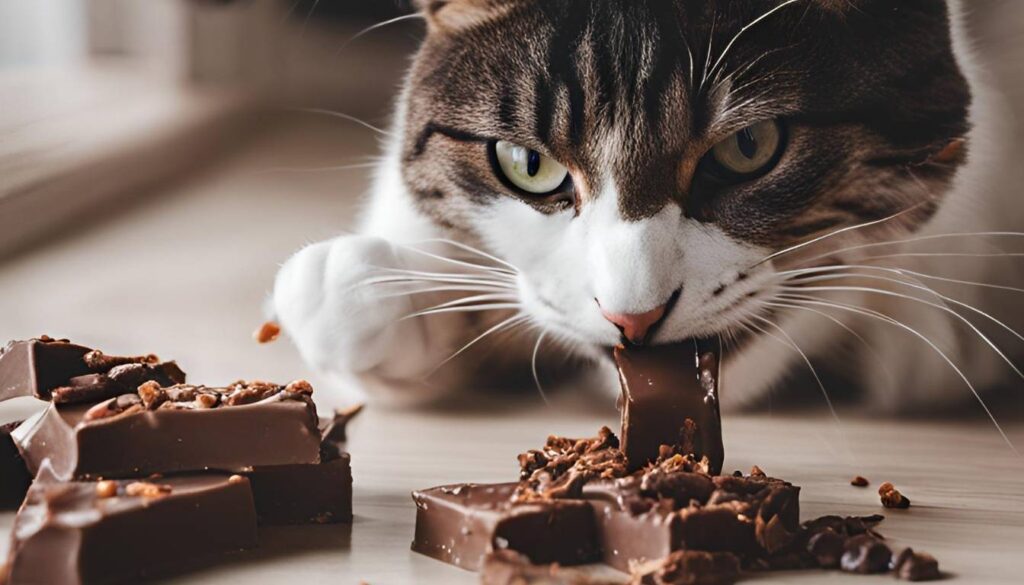
Chocolate poisoning is a big risk for cats. They can’t break down some chocolate compounds. Even a little bit can be very dangerous.
The common signs of chocolate poisoning in cats are:
- Vomiting (in about 75% of cases)
- Diarrhea
- Increased heart rate
- Rapid breathing
- Restlessness and hyperactivity
- Excessive thirst
As poisoning gets worse, cats may show more serious signs. These can be very bad for their health:
- Tremors
- Seizures
- Muscle rigidity
- Cardiac arrhythmia
“Even small amounts of chocolate can trigger dangerous reactions in cats” – Veterinary Toxicology Expert
How fast symptoms show up is very important. Symptoms can start in 1-2 hours after eating chocolate and can last up to 72 hours. Watching your cat closely is key to catching early signs.
Different chocolates are more or less risky. Dark chocolate and unsweetened baking chocolate are the most dangerous. They cause about 90% of severe cases in vet emergencies.
If you think your cat ate chocolate, call your vet right away. Acting fast within 2 hours can cut the risk of serious problems by more than half.
Emergency Response: What to Do If Your Cat Eats Chocolate
Chocolate is a big danger for cats. If your cat eats chocolate by mistake, you need to act fast. Quick action is key to save your cat.
Acting quickly can really help your cat. The first few minutes after they eat chocolate are very important. They can prevent serious problems.
Critical First Steps
- Stay calm and assess the situation quickly
- Remove any remaining chocolate from your cat’s reach
- Do not attempt to induce vomiting at home
- Contact your veterinarian immediately
Essential Information for Your Veterinarian
When you call your vet, tell them all about the chocolate incident:
- Type of chocolate consumed
- Approximate amount ingested
- Your cat’s current weight
- Time since chocolate consumption
- Any observed symptoms
Potential Treatment Approaches
Vets may use different treatments for chocolate poisoning:
- Professional vomit induction
- Activated charcoal administration
- Intravenous fluid therapy
- Continuous heart monitoring
- Supportive care and observation
“Swift veterinary intervention can significantly improve your cat’s chances of full recovery.” – Veterinary Emergency Specialists
No chocolate is safe for cats. Your fast action and vet care are crucial. They are the most important steps in handling this emergency.
Prevention Strategies to Keep Your Cat Safe
To keep your cat safe from chocolate poisoning, you need to be proactive. About 50% of cats eat things they shouldn’t. So, making a safe space for them is key.
Here are some important steps to prevent chocolate poisoning:
- Store chocolate in sealed, high cabinets where cats can’t reach it.
- Teach your family about the dangers of chocolate.
- Keep chocolate away from countertops and dining areas.
- Use childproof locks on pantry and kitchen cabinets.
Being careful is your best defense against chocolate poisoning emergencies. Be extra careful during holidays or celebrations. Chocolate treats are more common then.
“Prevention is always better than cure when it comes to your cat’s health.” – Veterinary Nutrition Expert
Make a detailed pet safety plan by following these steps:
- Check your home for safety regularly.
- Keep a list of toxic foods in the kitchen.
- Teach everyone in your home about pet diet guidelines.
- Have a special place for treats.
Cats are naturally curious. About 25% of them might eat harmful things. So, always watch them and take steps to prevent accidents.
Safe and Healthy Treat Alternatives for Cats
Keeping your cat’s diet healthy means choosing the right treats. Chocolate is a big no-no, but there are many tasty, safe options. These treats can make your cat happy without harming their health.
Vets say it’s important to give your cat treats that are both tasty and good for them. They help keep your cat healthy and happy.
Vet-Approved Snack Options
Your cat can enjoy many healthy treats. These treats are not only tasty but also good for their health:
- Small pieces of cooked chicken or turkey (unseasoned)
- Tiny amounts of fish like salmon or tuna
- Occasional raw or cooked vegetables like carrots
- Plain, cooked eggs
Homemade Cat Treat Ideas
Making your own treats lets you pick the ingredients. Here are some easy recipes:
- Baked chicken strips
- Tuna cubes
- Pureed pumpkin treats
- Freeze-dried meat morsels
Commercial Cat Treats Selection
When buying treats, look for these qualities:
- High-quality protein sources
- Minimal artificial additives
- Formulated for cats
- Match your cat’s dietary needs
“Choose treats that complement your cat’s balanced diet, not replace it.” – Veterinary Nutrition Expert
Treats should not make up more than 10% of your cat’s daily calories. This helps keep their diet balanced and prevents weight problems.
Why Size and Age Matter in Chocolate Toxicity
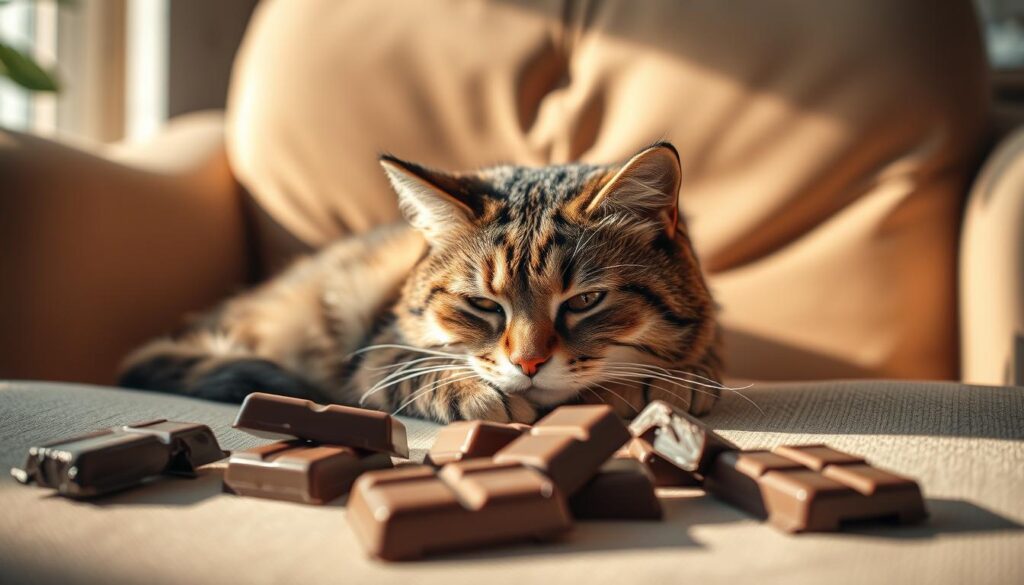
The size and age of your cat are key in chocolate poisoning risks. Smaller cats and kittens are more at risk because of their lower weight and developing bodies.
Understanding how size affects chocolate poisoning in cats is important:
- Kittens metabolize toxic compounds much slower than adult cats
- Small cat breeds have less body mass to dilute chocolate’s harmful substances
- Body weight directly influences the severity of chocolate poisoning
Age also plays a big role in cat health risks from chocolate. Young cats under one year old have less developed liver and kidney functions. This makes them more likely to get sick from theobromine and caffeine.
| Cat Age Group | Chocolate Toxicity Risk | Metabolic Efficiency |
|---|---|---|
| Kittens (0-6 months) | Extremely High | Low |
| Young Cats (6-12 months) | High | Developing |
| Adult Cats (1-7 years) | Moderate | Normal |
| Senior Cats (8+ years) | Moderate to High | Reduced |
Pro tip: Always keep chocolate completely out of reach, especially for smaller and younger cats who are most vulnerable to chocolate poisoning.
“Prevention is always better than cure when it comes to protecting your feline friend from chocolate’s toxic threats.” – Veterinary Nutrition Experts
Understanding the Timeline of Chocolate Poisoning
Time is crucial when it comes to chocolate poisoning in cats. Knowing the timeline can save your cat’s life in emergency situations.
Chocolate toxicity in cats happens fast. Symptoms usually show up 6 to 12 hours after they eat it. The speed and how bad it is depends on:
- How much chocolate they ate
- The type of chocolate
- How heavy the cat is
- How their body processes things differently
The toxic part, theobromine, can cause serious problems. Cats can’t break it down as fast as people, making them more at risk.
“Swift action is crucial when chocolate ingestion occurs” – Veterinary Emergency Specialists
Here’s a detailed breakdown of the potential chocolate poisoning timeline:
| Time After Ingestion | Potential Symptoms |
|---|---|
| 0-2 hours | Initial digestive disturbances |
| 6-12 hours | Significant clinical signs emerge |
| 12-24 hours | Risk of severe cardiac and neurological complications |
| 24-48 hours | Potential long-term health impacts |
About 50% of cats might not show symptoms right away. So, watching them closely is key. Getting your cat to the vet fast can really help them get better.
Conclusion
It’s important to know if cats can eat chocolate for their safety. Chocolate can be very dangerous for cats and even life-threatening. No chocolate is safe for cats, no matter the type or amount.
Keeping your cat safe from chocolate is your responsibility. Make sure chocolate is out of reach, teach others about the dangers, and watch for signs of poisoning. If your cat eats chocolate, get them to the vet fast. The Pet Poison Helpline is at +1 (855) 764-7661 for help.
But chocolate isn’t the only danger for cats. Foods like onions, grapes, and alcohol can also harm them. By being careful about what your cat eats and their environment, you can keep them healthy and happy.
FAQ
Can cats eat even a small amount of chocolate?
No, cats should never eat chocolate. Even a little bit can be very harmful. This is because cats can’t break down theobromine and caffeine well.
What makes chocolate so dangerous for cats?
Chocolate has theobromine and caffeine, which are very bad for cats. Cats can’t break these down like humans do. This can lead to serious health problems, like heart issues and damage to the nervous system.
What are the most toxic types of chocolate for cats?
Dark chocolate and cocoa powder are the most dangerous. They have the most toxic compounds. Baking chocolate and pure cacao are especially risky, even in small amounts.
What symptoms should I watch for if my cat eats chocolate?
Watch for vomiting, diarrhea, and restlessness. Also, look for an increased heart rate, tremors, seizures, and too much thirst. In serious cases, cats might have muscle rigidity, heart problems, and even breathing issues.
How quickly do chocolate poisoning symptoms appear in cats?
Symptoms can start in 6-12 hours after eating chocolate. But, they can appear as soon as 2 hours or up to 24 hours later. This depends on how much and what kind of chocolate was eaten.
What should I do if my cat accidentally eats chocolate?
Call your vet or an animal poison control center right away. Don’t make your cat vomit unless a vet tells you to. Tell them how much and what kind of chocolate your cat ate. Be ready to take your cat to the vet quickly.
Are some cats more at risk from chocolate poisoning?
Yes, smaller cats, kittens, and cats with health problems are more at risk. They can get very sick from even a little bit of chocolate because of their size and health.
Can white chocolate harm my cat?
Yes, white chocolate is not safe for cats. It has fat, sugar, and additives that can cause stomach problems, pancreatitis, and other health issues.
How can I prevent my cat from accessing chocolate?
Keep chocolate in sealed containers in high places. Tell family members about the dangers. Keep chocolate away during holidays and be careful of treats like baking ingredients and candy dishes.
Are there safe treat alternatives for cats?
Yes! Choose vet-approved treats like cooked chicken, commercial cat treats, or special feline snacks. Always introduce new treats slowly and in small amounts to keep your cat’s diet balanced.
Source Links
- Can Cats Eat Chocolate | Why It’s Toxic for Your Feline – https://felinefancy.co.uk/blogs/cat-care-tips/can-cats-eat-chocolate?srsltid=AfmBOooiBjvJRBfsmhCEpHMNstuPcqZq3ezaW1K1vOLulLPKxSpADvV8
- Can Cats Eat Chocolate? The Dangers Explained | Cat Boarding Hotel Laguna, Mission Viejo, Anaheim, Santa Ana, CA | Cats Luv Us – https://www.catsluvus.com/cat-grooming/can-cats-eat-chocolate-the-dangers-explained/?srsltid=AfmBOorDvtT_sPj9DZKC3rsLQNLqPqBTaBuiJ2rQODo-MBYTmRIrT2Yo
- Is chocolate poisonous to cats? | Blog – https://www.cats.org.uk/cats-blog/why-is-chocolate-poisonous-for-cats
- Can Cats Eat Chocolate Cake? Vet Reviewed Facts & Safety Guide – Catster – https://www.catster.com/nutrition/can-cats-eat-chocolate-cake/
- Can Cats Eat Chocolate? No! – https://www.pumpkin.care/blog/can-cats-eat-chocolate/
- My Cat Ate Chocolate! Our Vet Explains Toxicity & What to Do – Catster – https://www.catster.com/ask-the-vet/my-cat-ate-chocolate/
- How Much Chocolate Is Toxic to Cats? – https://www.thesprucepets.com/how-much-chocolate-is-toxic-to-dogs-and-cats-3385506
- Can Cats Eat Chocolate? – https://noblevetclinic.com/blog/can-cats-eat-chocolate
- What To Know about Chocolate Poisoning in Cats and How to Protect Them | Emergency Veterinary Care Centers – https://evcc.com/blog/can-cats-eat-chocolate/
- Cat Chocolate Toxicity Calculator – https://www.omnicalculator.com/biology/cat-chocolate-toxicity
- Cacao Tree is Toxic to Cats 🍫 – https://greg.app/cacao-tree-toxic-to-cats/
- Animal Hospital of North Asheville – https://www.ahna.net/site/blog-asheville-vet/2024/07/15/cat-chocolate
- Veterinarian guide: Can cats eat chocolate? – betterpet – https://betterpet.com/can-cats-eat-chocolate/
- Can Cats Eat Chocolate? Human Food for Cats – https://www.kinship.com/cat-nutrition/can-cats-eat-chocolate
- What your cat should not eat – https://www.petplan.co.uk/pet-information/cat/advice/what-your-cat-should-not-eat/
- Can Cats Eat Chocolate? What To Do if Your Cat Eats Chocolate – https://www.petmd.com/cat/poisoning/can-cats-eat-chocolate
- Can Cats Eat Chocolate – Chimacum Valley Veterinary Hospital – https://chimacumvet.com/blog/can-cats-eat-chocolate-2/
- What Do Cats Eat? (Ideal Cat Diet, Portion Size, Frequency, and Feline Nutrition Guide) – https://www.linkedin.com/pulse/what-do-cats-eat-ideal-cat-diet-portion-size-frequency-anees-ashraf-cslmf
- What should I feed my cat? – RSPCA Knowledgebase – https://kb.rspca.org.au/knowledge-base/what-should-i-feed-my-cat/
- CAT’S LOVE | Which foods are toxic for cats? – https://www.catslove.com/en/toxic-foods-for-cats
- Can Cats Eat Sugar? – https://conservationcubclub.com/can-cats-eat-sugar/
- Can Cats Eat Chocolate? Vet Reviewed Facts & Safety Guide – Catster – https://www.catster.com/nutrition/can-cats-eat-chocolate/
- Can Cats Eat Chocolate? What Every Pet Owner Needs To Know – Kate’s K9 Pet Care – https://katesk9petcare.com/can-cats-eat-chocolate/

